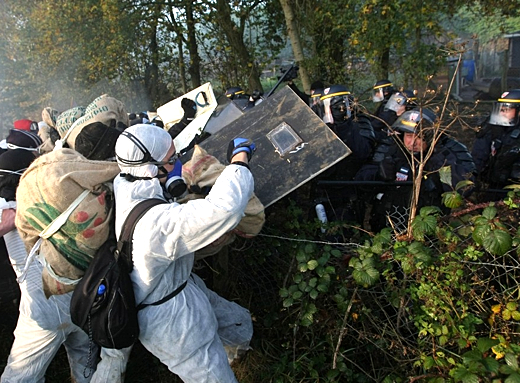By Jan Lundgren on 28 November 2011 for Culture Change -
(http://www.culturechange.org/cms/content/view/799/65/)

Image above: Detail of computer/photo illustration of Mother Earth suckling humanity. From (http://mattthesamurai.deviantart.com/art/Mother-Earth-177564720).
"...you may be convinced we have already sealed our fate and that humans may well go extinct possibly in a matter of decades, tracking the worst potential climate chaos. So why bother to hang around and breathe out your carbon dioxide? Do you really believe that instead of our waking up -- I refer to the 90% (?) who are not yet ecologically conscious enough to act for a healthy Earth -- we will be walking around like zombies, dropping like flies, without coming together to put up a fight to protect Earth's life support systems?"
More than half of my essays for Culture Change, going on for over ten years now, have sprung from sudden realizations. They come like a flash of insight, or gut feeling about some "new" piece of truth. I just had another one yesterday, in the shower, that seemed worthwhile to convey. Just before that, on the way home, I had another one as I negotiated the crossing of a boulevard on foot: upon general collapse there will no longer be deadly cars whizzing at us when we're trying to cross a street. I mused that most consumers seem to prefer the ongoing toll from cars, even upon a family member, to letting go of our technotopia.
But cars, roadkill and land use are old subjects for Culture Change.
On to the realization embodied in the title of this essay: I've written of the same idea before, but only in passing. Now I give it full attention after seeing or feeling the whole idea more intensely. This one is bound to meet with skepticism by the jaded, the dejected, and any reductionist-science ridden critics. If my vision instead gives you joy, I hope it's not because you're what some might deride as a flaky New Ager, or because you've been smoking something outrageous.
The movement of all movements...
will be the saving of the Earth. When the movement really gets going it will make your head spin. Incredible, but real. It is inevitable, but has been slow (relatively speaking) to climb to preeminence. Thus many people have become tired of waiting for major positive change -- whether they continue to recycle and save energy or not. Some already gave up on their certainty, of perhaps decades ago, that the rotten system they rebelled against or tried to opt out of could be defeated or would self-destruct well before the year 2000.
They -- or you -- may be right that we will eventually fail as a civilization and a species, and go extinct on a world we have gone a long way toward killing.
But I may show in this essay how people will at least go down trying to save the Earth and themselves, as many find themselves coming around perhaps 180 degrees from their current consciousness and set of priorities. But it won't be so strange: there has long been a suppressed but thriving undercurrent of Earth-loving collaborators seeking fulfillment rather than attaining "all the toys." It has enjoyed confirmation by successfully coping with resource limits, such as peak oil, to enhance community and regeneration via permaculture.
That we will someday in the not too distant future come together to save the Earth seems so unlikely at the moment, to a large segment of us, that it appears as wishful thinking. To some, the Occupy movement isn't strong enough, is inchoate, or it is off base.
To others, skepticism builds when a technological fix and the vaunted "free market" increasingly seem to offer no certain solution. Most troubling to some is our division in U.S. politics today. Unity may appear insurmountable, as indicated by the top headline in Alternet's Nov. 28 edition: "To Conservatives, Climate Change is Trojan Horse to Abolish Capitalism" (originally "Capitalism vs. the Climate" from The Nation).
But the problem in our country and the world is not "the conservatives" or even capitalism. It is rather that materialist culture has achieved terminal overshoot. Against our common interest, divisions in our minds keep us from coming together to solve much. Fortunately, as the system self-destructs, and as conservatives will be victimized and disaccommodated perhaps as much as liberals and the poor, people will have to rapidly adapt to the basic human tendency to make community function for one and all.
Perhaps not immediately, but eventually. Even if a record amount of blood will be shed as people fight for individualistic advantage during dire shortages, there is little basis for being certain that all human blood will be shed across the world, such that we wipe ourselves out. People will at some point come together and utilize their (degraded) local environment cooperatively and ecologically rather than perish.
It is at the point when we begin to work with nature as a humble partner that our division is over.
Our division has been not only social, preventing unity among the whole population: Western culture long ago developed a separation between the mind and nature. This one-sided divorce was a delusion that could not last forever, when we ultimately need to return to a culture of working with nature as a respectful partner. Only such a relationship safeguards the ecos ("home" in Greek, root of "economy" and "ecosystem").
We can and must heal our planetary home as well as ourselves individually. The two go together: the epidemics of cancer and other "civilized" diseases are traced largely to poisoning our environment: our water, air, soil, and food. Stress is also deadly when we attempt to keep up in the mechanized world at an unnatural pace.
The complete rebirth of appreciating and caring for nature will come about not because we simply wish it or that we have a blind, religious-like faith. Some of us are inclined to believe in a Gaia-like consciousness existing around us and within us. More of us can just agree with modern physics that we are all connected to everything in the universe, and that the observer affects the observed just by observing. But there is ample logic in support of a trend toward honoring the Earth as the only game in town. You be the judge; read on.
We have sunk so far towards oblivion, we're like a drunk in slow motion who has fallen off a boat in the dark into the water. Only upon the realization of what has happened, and that drowning is imminent, does he make a struggle for dear life. He summons all his strength and concentration, asks for help (screams), and tries to pull himself up the swimming ladder (assuming there is one) to get back on deck.
There are realizations aplenty, with bigger ones on the way. The poor state of the ecosystem at the hands of modern industrialized humans is clear from this acknowledged interrelated crises: ocean acidification, melting of the tundra and methane-ice, deforestation, sea-level rise from loss of ice caps and glaciers, tropical diseases moving to what have been safe temperate climates, massive radiation releases, more wars, the plastic plague, drought, torrential rains, floods, crop-killing freezes, wind storms, tsunamis, and whatever else.
Only one or two of those are potentially bad enough to kill millions upon millions, as future events play out. We're busy slashing the web of life thanks to voracious human appetites, causing tremendous loss of biodiversity. Climate models have too conservatively forecast these "realizations," as they become ever more intense and more frequent.
If these phenomena's increasing impact sounds questionable to you, stop here and go get educated. It's not on Fox News, but the science and journalism are both easily accessible and convincing for validating the trends.
Nevertheless, I have a kind of optimistic analysis/belief/faith. If you are inclined to dismiss it as lacking in objectivity or realism, you may be convinced we have already sealed our fate and that humans may well go extinct possibly in a matter of decades, tracking the worst potential climate chaos. So why bother to hang around and breathe out your carbon dioxide?
Do you really believe that instead of our waking up -- I refer to the 90% (?) who are not yet ecologically conscious enough to act for a healthy Earth -- we will be walking around like zombies, dropping like flies, without coming together to put up a fight to protect Earth's life support systems? Why would this have to be? It has no foundation as the most likely scenario, but yes it is possible.
More likely is that people first receive enough painful lessons of climate destabilization and overpopulation, suffering or witnessing major hits that offer inescapable messages. Then the vast majority will eventually get it. I'm not saying that more damage won't occur as people may keep being slow to wake up. Or that we will necessarily succeed.
After all, the hour is late, and a runaway greenhouse effect may be already locked in. But at least, as it dawns on us all that we have slapped Mother Nature too hard to escape her wrath, and the consequences of our actions as polluters and destroyers of forests are finally universally obvious, we will want to come back to her breast and suck the essential life-giving nourishment we have dared disdain, neglect and pollute.
A timeline could go like this:
The Durban climate change meeting, organized by the U.N. and running this week, ends in the predicted failure. It seems to be from a result of the impasse of top emitter countries and lesser polluting countries, all fixated on continued economic "well-being" of business-as-usual economics.
This bad news accompanies reminders that greenhouse emissions have just been found to be actually increasing and accelerating, closing the window of reversing the warming trend. People react internally, mainly, in disgust and despair.
Then another climate-change related weather event hits that kills many people, shocking the senses. This becomes a wake-up call that pulls us away from the workaday focus on paying our bills and diverting ourselves with infotainment. The weather event even obscures relentless fear-mongering by certain governments about wars and terror. After the weather event blows over, and we lament the loss of a staggering number of hapless humans living at sea level, for example, people get on with their lives either as employees or the hungry unemployed.
But then there's another devastating hit from another direction: material culture takes a dive, whereby the fragile financial system collapses. The house of cards transforms into a pile of worthless, toxic trash that no longer provides the wherewithal for cash to buy essentials. This hit causes mass deprivation and riots by starving people. We shall see how widely and deeply this spreads.
Then as the climate's unreliability continues and worsens, making it hard for survivors of the economic crash to overcome the loss of ample cheap energy and materials that had made life deceptively easy, people see that nature is no longer providing what she used to so easily and kindly.
Without the ability to shop for "everything," people must look to their immediate environment for the food, water and the materials needed for clothing, shelter and heat. And they see that these basic resources are badly lacking and cannot be harnessed through once-plentiful industrial energy. The solar panels and windmills aren't feeding people or reconstituting a thriving consumer economy.
Further expanded awareness of our ecological plight then sinks in as shortage and struggle are the order of the day (at least for most survivors).
Meanwhile, a rising number of people are saying, "I told you so -- we mistreated the ecosystem." When enough people really feel this, and see it all around them, any further blatant anti-Earth behavior will meet disapproval. Perpetrators will be defensive, rightfully feeling blameless for trying to survive. Conflict will have to be resolved somehow, perhaps with a form of limited civil war.
But as time goes on, and people are forced to scrape an existence out of the natural endowment -- tragically shrunk -- and resources cannot be brought from distant exploited lands, cooperation and sensitivity must surely mount. Growing food that doesn't come up quite as easily anymore, due to ongoing soil erosion, will necessitate reactive policies by the community to save soil. Or, to conserve water and not waste compost materials. This change in community values could all take place in little more than one harvest season. Perhaps permaculture and reforestation will be prime. No; screw the "perhaps;" they will be prime.
After a while, say another year, hyperawareness of cause-and-effect sets in. Climate events that make life harder, and deprive the people of a large portion of their food supply -- decimating their numbers until equilibrium is reached -- is connected in their minds with past abuse of nature. It is increasingly lamented, railed against, and deemed intolerable for present and future survival.
Moreover, the knowledge of once prevalent pristine nature, before petroleum extraction, nuclear waste, species extinction, depletion of fisheries, is felt more and more strongly. A swing in human thought or feeling could be manifested in Mother Earth worship, and non-adherents dealt with harshly
.
Are we a hopeless plague of locusts?
This is not to say that all is then going fairly well, or that there is no longer much strife. In some areas there may be such competition for remaining resources that cooperation cannot ever get a leg up. Bioregional nations and tribes might bite the dust.
Unspeakable violence and waste of human potential and natural endowment is wasted -- but not everywhere. Survivors will no doubt see that it's time to bury the hatchet and get their act together, if they are to gather or grow any food and drink clean water. If this sounds too optimistic, and one disagrees by saying "people will never learn; might makes right; those who have the biggest guns and most bullets win; etc. etc..." this position is to view humanity as a hopeless plague of locusts that strip everything around.
As dismal as the outlook may be for coping with the damage already wrought by modern humanity and that can continue a bit longer, at some point it is reasonable that people will put two and two together and come up with four. (Today's climate-change denialists are coming up with "three" or "five.")
Simultaneously, the disappointed, skeptical observers who have given up on humanity's ability to overcome individual self-interest -- even though our tribal history as part of nature is our overwhelming experience the planet -- may cling to their pessimism and act in a narrow fashion. After all, they have a point that there's much to be said for the stupidity of humans and their blindness. More and more people have concluded that the future is hopeless, and this feeling can spread before it may turn around.
But whoever survives the coming additional lessons of ecology will apply common sense and reason: we can take and take from the Earth only so long, and we have to begin giving back and loving the Earth if we are to remain part of the biosphere. Or else, our bones will become part of a fossil record for no one to uncover. Life is then for all we know over. Is everyone going to just let that happen, without a fight? I don't think so.
Can you visualize peaceful villages where tasks are divvied up fairly, where supportive extended families take the drudgery of child rearing out of the hands of what might otherwise be a sole parent struggling to survive? Can you glimpse celebrations of life to honor the changing seasons? Can you imagine the arrival of traders into a town or village, whether on beautiful sailing ships or one man on a horse?
There won't be any neon signs or wide roads crammed with polluting machines threatening to run over you. Instead there will be walking paths, craftspeople, artists, gardeners, and councils of respected elders. Knowledge and appropriate technology will be shared. Study of the past and dreaming of a better future, and planning by consensus, will prevail.
But the selfish urge to exploit and oppress people and nature will not revive and ensue, because we've been there and done that. It didn't work, and after the punishing lessons through the year 2012 or 2013, or perhaps 2021 (what have you), we will have seen mistakes aplenty and decided enough was enough.
It is easy to say instead, as long as once can insulate him/herself by buying whatever is needed for a comfortable lifestyle, "I reject a vision of simple eco-village living, for I believe in progress and competition." Or, "There has to be strong authority, and anyway we may end up under feudal, dismal rule, or overrun by gangsters or marauders."
But as I should have told the obese woman in a sweat lodge, who said my car-free lifestyle was okay for me but not for her, "you may not always have the choice to avoid changing, because of loss of oil supply." Dealing with challenges can mean also creating what we choose to, together, as one people.
I'll take simple living and honoring nature, whether the Earth is alive as a being or not, over an end to our existence and shutdown of life-giving nature. An in-between, never-ending scenario of injustice, misery and brutality doesn't ring true, because it would eventually fail to sustain us or have to be overcome in this increasingly challenging natural world.
.











